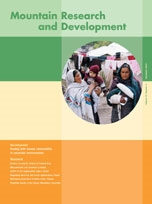Desastres de Origen Natural en Colombia 1979–2004, edited by M. Hermelin. Medellín, Colombia: Sello Editorial EAFIT, 2005. 247 pp. US$27, includes airmail postage. ISBN 958-8173-89-2.
The 1985 eruption of the Colombian volcano Nevado del Ruíz was a wake-up call for the need to understand and communicate the risk of natural disasters in Colombia and other mountainous countries. The eruption and subsequent lahar caused more than 20,000 lives to be lost. The geographical and historical contexts, socioeconomic and environmental effects, and painful lessons about the importance of disaster preparedness and effective crisis management are discussed in one of 18 chapters of this informative volume, which chronicles and examines disasters caused by natural events in the 25 years from 1979 to 2004 in Colombia.
The (Spanish) language of the book is appropriate for lay readers and decision-makers, while the level of detail will be welcomed by geologists, disaster-managers, and advanced students. The volume makes a particularly important contribution to the sparse Spanish-language scientific literature on natural disasters in Andean countries and was written for the Colombian public and others curious about Colombia's natural disasters—with the admonition (p 51) that a society that does not know the history of its risks and disasters is condemned to suffer more each time. Colombia's high volcanic mountains, steep slopes, coasts, and dynamic rivers have caused a rich assortment of disasters of natural origin—earthquakes, volcanic eruptions, landslides, floods, tsunamis, and coastal erosion. Yet neither the events nor the insights gained from them are unique to Colombia, and a book of this quality thus merits global attention and distribution.
The volume presents papers written by scholars from the Observatorio Sísmico del Suroccidente (Seismic Observatory of the Southwest), the Universidad del Valle (Cali), and the Environmental Geology Group of the Department of Seismic Engineering of the EAFIT University. Between Hermelin's introduction and epilogue, almost all chapters focus on one event or group of events. Chapters are remarkably even in quality and length and follow a basic template that includes a description of the geographic location; an overview of geological and historical contexts; important geological, social, and managerial details; and an assessment of socioeconomic and environmental impacts. Each chapter begins with abstracts in Spanish and English and ends with a bibliography. Some authors include sections giving information about causes and characteristics of a type of event, and others provide additional detail about event management or event analysis. Each chapter is illustrated with at least one map and one photograph.
Most chapters successfully integrate physical and social aspects of a disaster. For example, Chapter 3, by A. Sarria, presents and analyzes the 1983 disaster caused by the magnitude 5.5 earthquake in the World Heritage city of Popayán, which left 283 dead and hundreds of others injured and affected. Damage was exacerbated by the adobe and clay roof construction of homes and other buildings, and by the age of the housing in the city. Termites had weakened the wood supporting old buildings, and perforations through many old walls to add plumbing and electricity had reduced structural strength. The tragic outcome of these conditions in Popayán could recur in many other Latin American cities with similar construction and histories. The chapter includes maps of fault patterns at regional and local scales around the city and summarizes the geological analysis. Post-event geological research completed the first detailed seismic microzonation study in Colombia, but further instrumentation and monitoring will be needed to validate models developed in the study.
Chapter 5, in which C. Garcia presents the 1987 landslide into a neighborhood of Medellín, describes the combined factors of mountainous terrain, weak rocks, heavy precipitation, and human vulnerability that led to around 500 deaths. The affected neighborhood had grown, not through city planning, but due to an influx of poor people who had migrated from rural areas; the failed mass was lubricated by water from a canal built with no technical control. Unfortunately, but predictably, some persons displaced by the landslide relocated in similarly unstable sites. In his epilogue, Hermelin reviews the relationship of risk to vulnerability and focuses attention on the problems of population growth and the growth of cities in spite of their physical constraints, problems important, but not unique, to Colombia.
The book has 20 authors, authorities from various backgrounds, but is remarkably coherent and consistent. Certain themes are reinforced in multiple chapters. The reader is reminded that naturally caused disasters frequently involve more than one process: eruptions generate lahars; earthquakes trigger landslides; and rain induces mass-movements as well as flooding. These relationships must be anticipated for effective disaster mitigation. Another recurring theme is the importance of recognizing the geological and geomorphic history of locations in disaster planning. Recent disastrous events had historic precursors: Nevado del Ruíz erupted in 1845; the 1979 tsunami on Colombia's Pacific coast was the second such event in the twentieth century; and the city of Popayán had to be rebuilt after a major earthquake in 1736.
Written assessments of natural disasters are extremely valuable for the vicarious experience they provide, the realities they impart, and the lessons they can teach about disaster management and mitigation from the perspective of intelligent hindsight. The most powerful recurring theme of this volume is the importance of conveying the science of disaster-producing natural events and the implications of the science to citizens and their leaders. The book takes a very successful step toward that goal and is a welcome addition to the literature of natural disasters.





